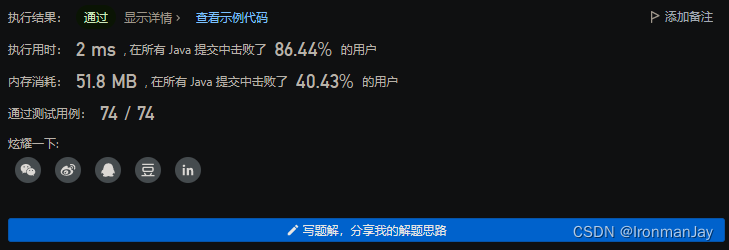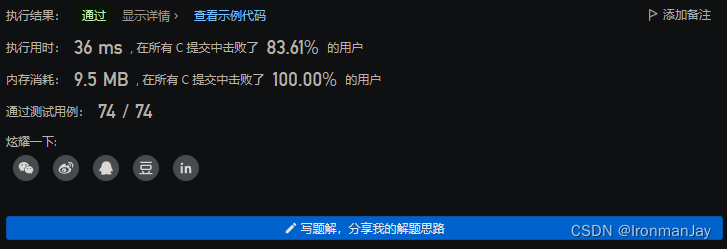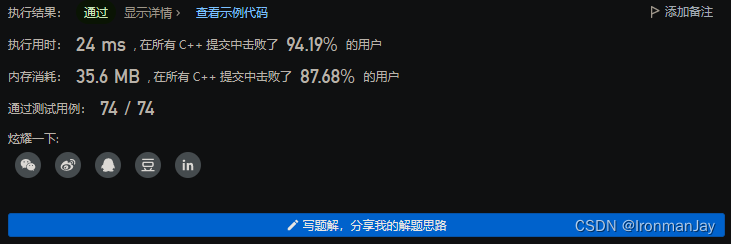一【题目类别】
- 滑动窗口
二【题目难度】
- 中等
三【题目编号】
- 1493.删掉一个元素以后全为 1 的最长子数组
四【题目描述】
- 给你一个二进制数组 nums ,你需要从中删掉一个元素。
- 请你在删掉元素的结果数组中,返回最长的且只包含 1 的非空子数组的长度。
- 如果不存在这样的子数组,请返回 0 。
五【题目示例】
-
提示 1:
- 输入:nums = [1,1,0,1]
- 输出:3
- 解释:删掉位置 2 的数后,[1,1,1] 包含 3 个 1 。
-
示例 2:
- 输入:nums = [0,1,1,1,0,1,1,0,1]
- 输出:5
- 解释:删掉位置 4 的数字后,[0,1,1,1,1,1,0,1] 的最长全 1 子数组为 [1,1,1,1,1] 。
-
示例 3:
- 输入:nums = [1,1,1]
- 输出:2
- 解释:你必须要删除一个元素。
六【题目提示】
- 1 < = n u m s . l e n g t h < = 1 0 5 1 <= nums.length <= 10^5 1<=nums.length<=105
- n u m s [ i ] 要么是 0 要么是 1 。 nums[i] 要么是 0 要么是 1 。 nums[i]要么是0要么是1。
七【解题思路】
- 利用滑动窗口的思想
- 仔细理解题意,要保证滑动窗口内0的个数不超过1个,所以此滑动窗口中保存的数组就是如果删除某个数字后,剩下的子数组就是元素全为1的最长子数组
- 使用右窗口去遍历数组,如果当滑动窗口中0的个数超过了1个,那么就移动左窗口,总之就是要保证滑动窗口内0的个数不超过1个
- 最后返回最大的窗口长度即可
- 还需要注意一个细节,题目要求我们必须删除一个元素,也就是说,最后的返回结果需要减1,因为减1之后的长度,才是全为1的最长子数组的长度
八【时间频度】
- 时间复杂度: O ( n ) O(n) O(n), n n n为传入数组的大小
- 空间复杂度: O ( 1 ) O(1) O(1)
九【代码实现】
- Java语言版
class Solution {
public int longestSubarray(int[] nums) {
int len = nums.length;
int left = 0;
int right = 0;
int zero_count = 0;
int res = 0;
while(right < len){
if(nums[right] == 0){
zero_count++;
}
while(zero_count > 1){
if(nums[left] == 0){
zero_count--;
}
left++;
}
res = Math.max(res,right - left + 1);
right++;
}
return res - 1;
}
}
- C语言版
int longestSubarray(int* nums, int numsSize)
{
int len = numsSize;
int left = 0;
int right = 0;
int zero_count = 0;
int res = 0;
while(right < len)
{
if(nums[right] == 0)
{
zero_count++;
}
while(zero_count > 1)
{
if(nums[left] == 0)
{
zero_count--;
}
left++;
}
res = fmax(res,right - left + 1);
right++;
}
return res - 1;
}
- Python语言版
class Solution:
def longestSubarray(self, nums: List[int]) -> int:
size = len(nums)
left = 0;
right = 0;
zero_count = 0
res = 0
while right < size:
if nums[right] == 0:
zero_count += 1
while zero_count > 1:
if nums[left] == 0:
zero_count -= 1
left += 1
res = max(res,right - left + 1)
right += 1
return res - 1
- C++语言版
class Solution {
public:
int longestSubarray(vector<int>& nums) {
int len = nums.size();
int left = 0;
int right = 0;
int zero_count = 0;
int res = 0;
while(right < len){
if(nums[right] == 0){
zero_count++;
}
while(zero_count > 1){
if(nums[left] == 0){
zero_count--;
}
left++;
}
res = max(res,right - left + 1);
right++;
}
return res - 1;
}
};
十【提交结果】
-
Java语言版

-
C语言版

-
Python语言版

-
C++语言版
